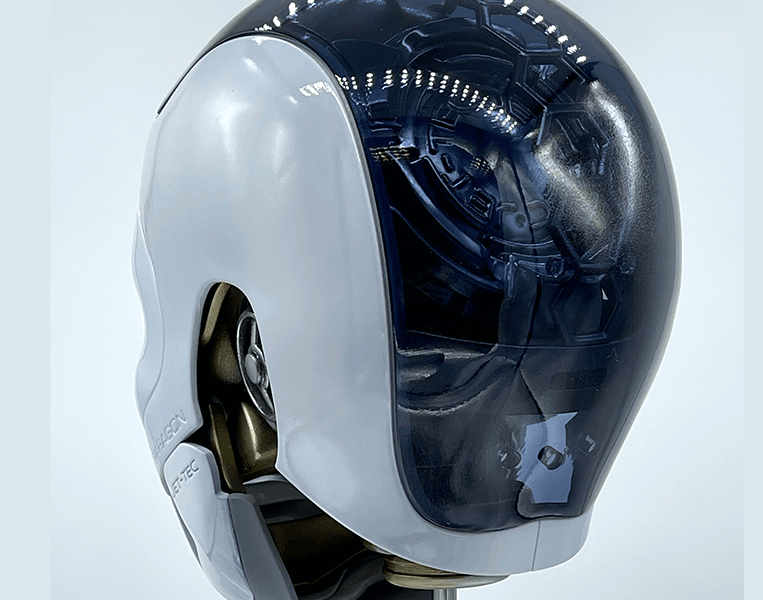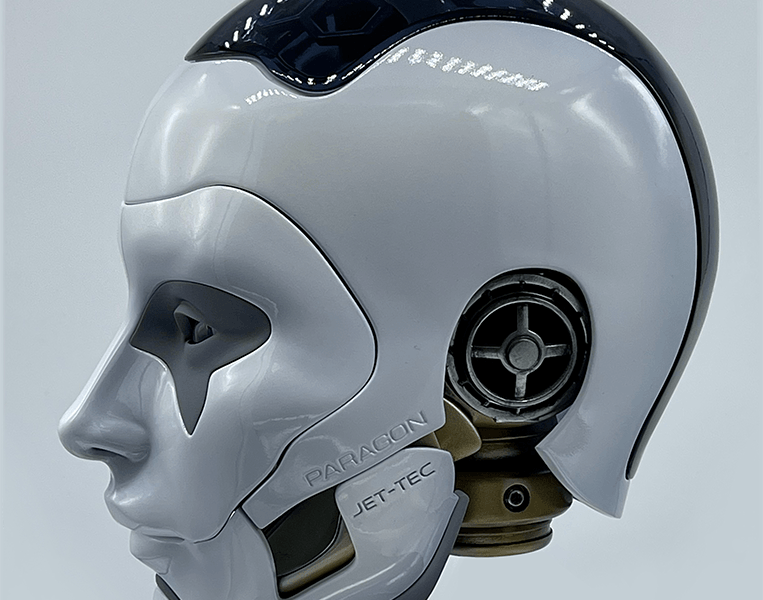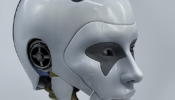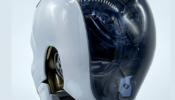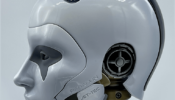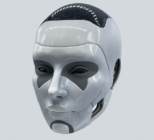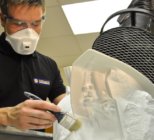Aurora is the brainchild of Jet Cooper, the creative director of Makinarium UK, a Pinewood Studios-based consortium of film professionals offering 3D modelling and fabrication services to the film industry.
Cooper’s pedigree in this area stretches back some 30 years, and his credits include a whole universe of Marvel props and costumes, Star Wars 7, James Bond, Terminator, Game of Thrones. The list goes on.

We at Paragon have completed a number of 3D print projects for Makinarium in recent months. Our NEO 800 SL capability offers large bed, fine detail printing on quick turnaround times. Jet was impressed with the quality of these and felt that more people in the entertainment sector should be aware of their power and material attributes.
So, when Jet suggested we collaborate on a project to showcase our combined 3D printing skills and modelmaking prowess, who were we to turn the opportunity down? As Aurora came to life in our model shop, we felt that an interview with her creator was absolutely part of the showcase.
He is currently entrenched in Marvel productions, so a daytime Zoom was out of the question. Instead, we lined up a time to chat after hours while he took some respite from creating features for Marvel’s next instalment. With Jet heading back to the studio after the interview, there was no option but to dive straight in.
Q&A with Jet Cooper
What was it that made you want to drive this project in the first place?
The film industry is, understandably, really protective over IP (intellectual property). It’s hard to show people your achievements without a long wait and a lot of permissions from the big corporations. When you have a great team of modelmakers and some brilliant technology, you want to show off.
I thought that we could create something that had no IP drawbacks; something that we could show to whomever we wanted, and that we could use to promote our respective skills without any worries about legal consequences.
Building our own hero prop was something both Makinarium and Paragon could benefit from. The collaboration meant I could have a professional print service and all the support you guys give at my disposal; and together we could show how we could use 3D printing to bring designs to the next level.
SL 3D print quality is just so good – and we’re talking industrial 3D printing here, not your home printer in your garage. The print can be used as the prop – there’s no need for creating casts anymore. We need to shout about this.
Of all the fantastical and mythical realms and creatures you have worked with, what made you go for an android as the basis of the project?
I thought quite hard about this. I wanted an item that would show a barrage of 3D printing types and different media, and its versatility with snap fit design. So, it needed to be something that would captivate the imagination and demonstrate engineering and design ability.
Sci-fi always works well in instilling intrigue, and the human form is instantly relatable. I wanted to design something that encapsulated everything you’d expect to see in a movie – something that you could break down into its constituent parts and the pieces would still look clean and attractive. An amalgamation, if you like, of everything sci-fi and a lifetime of exposure to the film industry and modern progression. A little like Apple products – super-clean, super-modern and yet still functional and tangible. I didn’t want anything hyper-realistic, though. The female form offers all that – clean lines, and yet totally and universally attractive and tangible. And an android would encapsulate everything.
Having decided on form, what were the next steps?
I tend to sketch in 3D rather than on paper so it was straight to the drawing board. This was going to be a project that evolved over time, so I wanted to make sure that she was not overly complicated, but she had enough components to showcase different technologies. Which components would be created through those processes would be up to you guys.
What was important was that she was simple to pull apart to show her integral workings and simple to put back together again. And that there were enough parts to really show off the printing ability and your skills in finishing and bringing her to ‘life’.
We were starting with the head – that is the part that gives the android her persona. I envisaged she’d be feminine but not too much so, and that she’d have very clean lines. She needed to convey, at the same time, that she was still a machine. Form and function were the objectives. Over the course of the day she emerged on the CAD with about 20 parts in her make-up.
Did you have any specific instructions about her construction?
Apart from wanting her to be 3D printed, obviously, I didn’t want to influence Paragon’s decision-making. This is a collaboration project. It was a bit of an experiment to see what you guys came up with. I knew I wanted SL – because it’s super-smooth and looks absolutely brilliant. I was not that keen on SLS, although I know some people really like it because it is really robust. It looks rough straight off the printer. But I also know that when it’s finished it can look pretty good.
Did you know that we used both resins we run on SL and SLS; and we made the flexible parts out of a vacuum casted rubber, having made the cores for the cast from SL?
I didn’t know about the vacuum casting. I know you can print in rubber but I’ve not seen the end results.
We could, but the rubber runs on our additive manufacturing technology and we really wanted our model makers to show the extent of their imaginations using SL and SLS. We gave them your CAD and left them to it. As the build progressed, what were your thoughts?
She looked great. I could see it all coming together – the transparent prints showing off her more industrial aspects, and the different textures contrasting with her overall porcelain features. I wasn’t sure what to expect when it came to the finished article, though. The magnets made it easy for assembly, and also showed how well the materials accepted inserts and bonding substances.
We called her Aurora because it means ‘dawn’ in Latin. And the dawn rises… You took delivery of Aurora on 14th June this year. What were your first impressions?
To be completely honest, I was blown away. She was beautiful. The different textures brought her to life and the finishing and attention to detail on every part was amazing. She looked better than many of the hero props that actually get used on screen. She wouldn’t need any digital touch-up. We have our own hero prop with which to promote our combined capabilities and she exceeds all my expectations.
What next for Aurora?
I think we have to build her body. I’ve already got ideas for her torso. It will be in keeping with her mechanised, organic look. We’ll bring in the animatronics experts from Makinarium. She will light up, she’ll have more depth. We’ll allow that to inspire us and then we’ll start thinking about her moving parts. But not just yet. For now, we’ll just enjoy showing her beauty to the world.



